
The leg shop
What happens when you lose a limb?

On a winter’s morning, June 4, Ian Winson was inspecting a water pipe in the Auckland suburb of Onehunga, a routine part of his job as an operational engineer for the city’s water provider, Watercare. As Winson crouched inside the pipe alongside a colleague, a mass of methane ignited 500 metres away up the line. The blast wave barrelled towards them in an instant. The other engineer was killed, and Winson was hurled clear out of the tunnel, across a worksite, and into another section of pipe—a distance of around 70 metres. Whatever it was that he hit along the way sliced off both his legs.
After that colossal bad luck, the good—Onehunga Fire Station was a few blocks up the road, and within minutes paramedics were applying tourniquets. Still, Winson had already lost of lot of blood, and by the time he arrived at Auckland City Hospital, the doctors weren’t sure he’d survive. A team of 15 operated on him for two hours, saving his life.
That was the first of 30 surgeries he’s had since the accident. Amputation can cause ongoing problems—it’s not just a case of sewing things up and moving on. Winson’s arms were badly damaged in the explosion, too, and one of his fingers required amputation. The surgeon did such a good job I didn’t notice it was missing until Winson pointed it out.
He also received a traumatic brain injury, which saps his energy and empathy. He no longer cries in sad movies, something he misses now. It’s affected his family, too—his younger son, who was two at the time of the accident, was retraumatised as he grew up and realised his father’s legs would never grow back.
Winson refused to settle for life in a wheelchair. Before the explosion, he ran marathons, completed Ironmans, and played provincial-level hockey. He was fit, a gym junkie, not afraid to train hard. After the accident, he turned his energy and willpower to getting moving again.
By the end of that year, 2011, Winson was working with a team of prosthetists and physiotherapists to get himself walking in his first pair of ‘stubbies’, or ‘little legs’. These are the training-wheel version of artificial legs, and he still wears them every day around the house. They have no knees—just a foot beneath a socket—so they’re easy to manoeuvre, and it’s not far to fall if something trips him up.
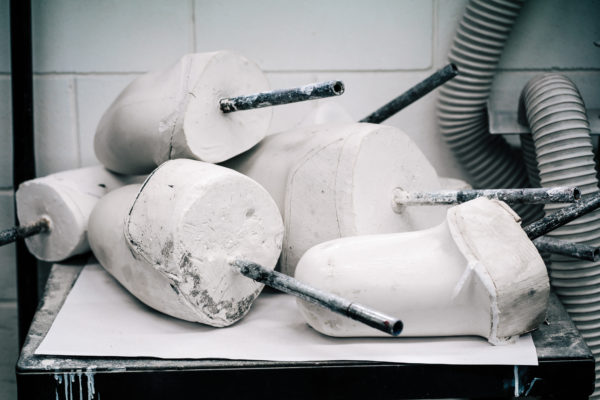
By 2012, he had graduated to full-length legs, and in 2015, he pedalled the New York Marathon on a recumbent bike with prosthetic legs—the first person to do so. With his muscular upper body and buzz cut, Americans assumed he was a war veteran. They opened doors for him, told him, “Thank you for your service.”
At first, he tried to explain what had really happened, but they weren’t really listening. After a while, he just accepted their gratitude.
Winson isn’t done yet. He wants to swim and dive, walk unaided on full-sized prosthetic legs, and, after that, to run again. A car accident last year damaged his shoulder and put a dent in his progress, but he’s got big plans for the rest of 2019.
“Ian’s the picture of motivation that you have to be to make it through that situation,” says his prosthetist, Jennifer Wright. “It’s really, really tough. He has a lot of ups and downs, but he’s a fighter, and he’s in a really good place now.”
[Chapter Break]
If you lose a limb, you’ll almost certainly end up at one of the five branches of the New Zealand Artificial Limb Service (NZALS), where expert prosthetists will create a new, bespoke one just for you.
The Auckland branch is located in Mt Eden, in an unremarkable building just off Dominion Road (a misspelled yellow council sign on a telephone pole points the way). I spent a day there, immersed in the world of prosthetic limbs, meeting the people who make them and the people who wear them. The paths that lead to this door—sliding and with wheelchair access—are many and varied, and none of them are easy.
Some people are born with limbs missing, or with one that doesn’t develop properly. More often, they’ve been in an accident, or had a leg amputated after complications from diabetes or vascular disease. Bone cancer can lead to amputation, too, as can meningococcal disease.
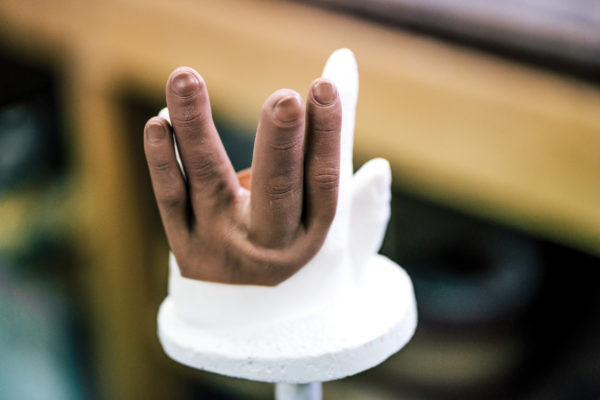
The men’s fitting room is the busiest place in the centre. (Men make up 74 per cent of NZALS patients nationwide, a gender difference that’s been attributed to their riskier behaviour and jobs, and the fact that men with diabetes are more likely to have a limb amputated than women.)
A heavily tattooed man practises with his new leg on a set of stairs and ramps. An elderly man tests his out by trialling his bowls stance. He lost his leg after a night out down the local social club, he says. Stumbling up his driveway, he bashed his foot so badly it required surgery. In the operating room, he caught an antibiotic-resistant infection, MRSA, and his lower leg was amputated to stop its spread. The night before the operation, he made sure he had time for one more session down at the club.
Sitting by the door, a fit-looking man in his 30s is meeting with a prosthetist and physiotherapist to fine-tune his prosthesis and choose a new foot. William Pike is the director of a youth development programme, a motivational speaker and part-time mountaineer. He lost his lower right leg during an eruption on Mt Ruapehu in 2007, and he has been coming to what he calls the “leg shop” ever since.
[Chapter Break]
Technically it’s the leg-and-arm shop, but upper limbs make up just 15 per cent of the prostheses the centre makes. Not everyone who loses an arm chooses to use an artificial one, says Jennifer Wright. It’s easier to replace the function of a lost leg than an intricate hand.
“If you only have one hand [amputated], you still have another that’s really functional, whereas if you don’t have two legs, you can’t walk. We still can’t replace all the things the hand does, and that makes it less useful. And when you put a prosthetic arm on someone, you take away their sense of touch—and you notice the weight of it more than with a leg.”
She lets me try on a prosthetic arm to see what it’s like. It’s supported by a pair of shoulder straps, and has a claw on the end that’s opened and closed by punching your elbow forward. It’s heavy and tiring, and I don’t feel much more capable than Captain Hook.
Wright is Canadian, short-haired and sparky, always ready with a laugh and a joke (“People call me ‘Always’,” she says as I write down her name.) She’s been at the centre just over a year, since moving to New Zealand with her Kiwi partner, a prosthetic technician who also works at the Auckland centre. But she’s been making artificial limbs since she was 20.
As a child, Wright spent hours in her dad’s workshop, building toy chests and tiny towns out of scrap wood, and changing the oil in the car. At 13, she got a Saturday job in his machining shop, shaping parts on the bandsaw, punch-press and lathe. Then in high school, her mum sent her to an engineering programme for girls. They were taken to a prosthetics shop, and Wright found it fascinating.
“I knew I wanted to work with my hands, but I had no idea what I would do until I saw that.”
Her weekend machining job turned out to be the perfect training for prosthetics. It’s an unusual career—a blend of science, art, construction and people skills. Prosthetists need a grasp of anatomy, torque, pressure and angles. They use sewing needles, bandsaws and grinding machines on a daily basis, manipulating leather, silicon, resin, and plaster of Paris with subtlety and perseverance. And they need to work sensitively with people undergoing one of the scariest, most vulnerable times in their life.
“The first thing you do is say, ‘Hi, how did you lose your leg?’ so it’s a bit of psychology and grief counselling as well,” says Wright. “But it’s very gratifying to have someone roll in in a wheelchair and then they walk out. That’s why I do what I do. There’s a lot of hair-pulling as well, I’m not gonna lie, but in the end, it’s all worth it.”
[Chapter Break]
There’s no such thing as a one-size-fits-all prosthetic limb—that’s where the hair-pulling comes in. Every stump is different, and a few millimetres can be the difference between a prosthesis that allows its wearer to participate fully in life and one that’s so uncomfortable it’s never worn.
The high-tech feet and hands do come standard. NZALS buys them in from a handful of international companies, and Wright estimates there are around 100 different feet on offer—from a simple foam foot to one with internal microprocessors that detect whether you’re walking up or downhill. Some have split toes for rough terrain, or shock absorbers, or adjustable heels for wearing with different shoes.
But the socket—the part where human meets machine—must be custom-made by a prosthetist, working with a prosthetic technician. Wright takes me out the back to what she calls “Santa’s workshop” to see how it’s done.
I follow her into a long room, where staff members each have a work bench to themselves.
“Mine’s not the messiest… Oh wait, no, it might be the messiest of them all,” she says. She’s probably right. The desk is covered in a surreal assortment of objects.
Behind a drill, a vice, and a coffee mug sits a plastic tub of disembodied hands. Pens, sandpaper, tape, earmuffs and notebooks are scattered around, and there are holders for screwdrivers, a fretsaw and other tools. There’s a whisky bottle—full of thinners, says Wright—and an array of differently shaped drill bits that look like torture instruments but are in fact used to grind parts of a socket into shape. (One of them, shaped like a spikey metal pinecone, is responsible for the plaster on Wright’s thumb.) Two half-finished prosthetic legs lean nonchalantly against the bench.
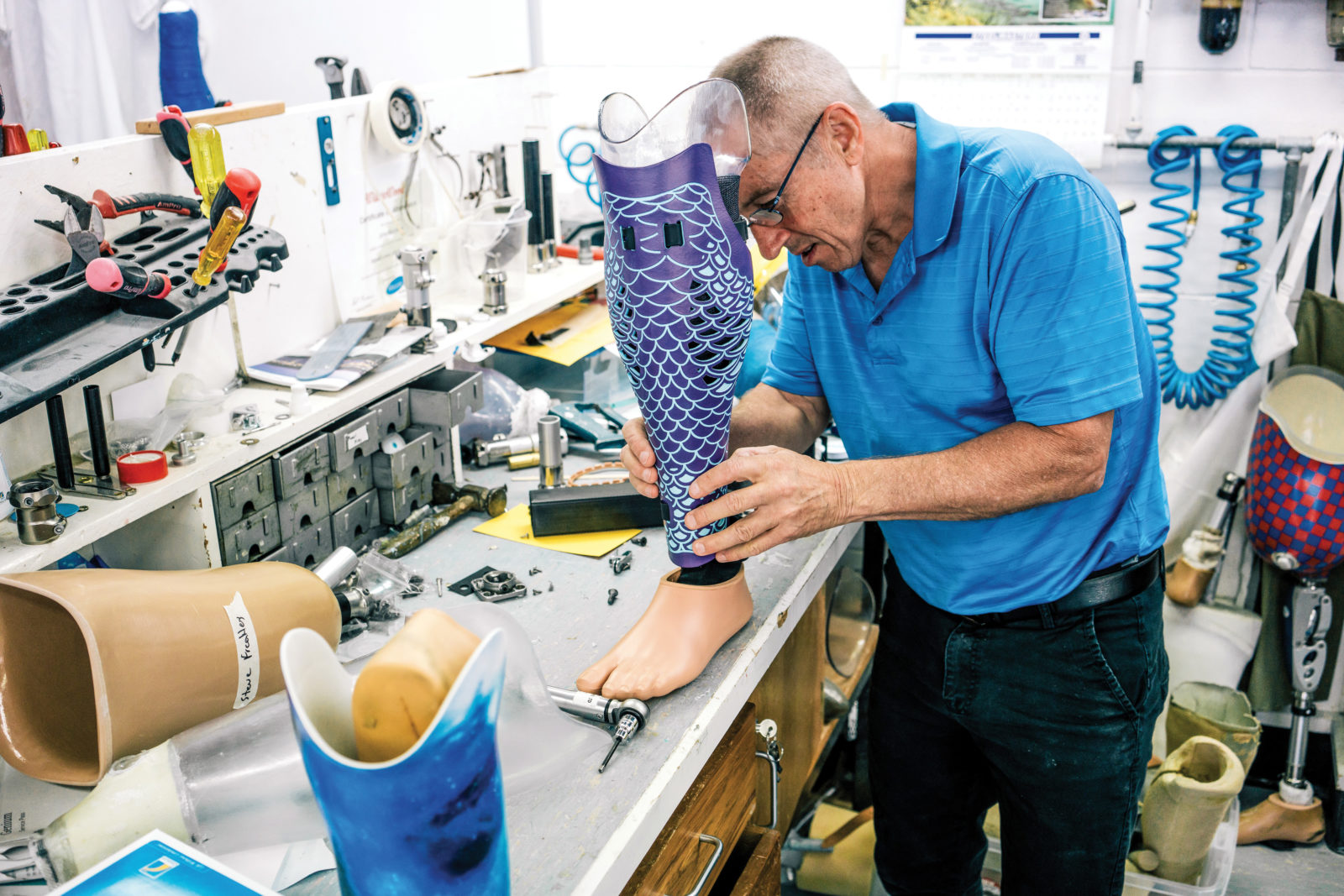

Building a socket takes around 15 hours, though it varies depending on the complexity of each case. To make Ian Winson’s prosthetics, Wright wraps each of his residual legs tightly in plaster bandages. Once set, the cast of each stump is filled with a plaster-of-Paris slurry to make two positive models of his remaining limbs.
Wright makes adjustments by hand to the plaster limb to distribute his weight onto the bony parts of his legs, then makes a test socket out of clear plastic—it’s heated to 160 degrees and draped over the model stump. When Winson tries on a socket, his skin turns white in areas where there’s pressure, so Wright can adjust it.
When they are both happy with it, a prosthetic technician builds the finished socket using layers of plastic, fibreglass, and carbon fibre—and that’s where things get creative.
I watch prosthetic technician Josh Hemara stretch a piece of Lycra, printed with orange and yellow flames, over a large leg socket—the fabric chosen by the leg’s new owner. Limb design is a collaborative process between amputee and prosthetist, but the decoration is up to the wearer. You can go as natural as possible or as radical as you like—the technicians get them printed down at the local shopping mall. Some have tā moko, cartoon characters, or other personal designs—Winson got the Ironman logo on one set.
“They’re going to wear it every day, so I want them to be proud of it, rocking out—like, ‘Look at my leg, it’s pretty choice’,” says Hemara.
He rips open a packet of ladies’ stockings and rolls one over the outside of the socket, then a stretchy PVA rubber bag over the top. He seals the bottom with electrical tape, vacuums out the air, then squeezes a clear resin inside the layers from a bag at the top. The flames brighten from matte to shiny. It looks awesome.
“I want every single one to be the best leg that person’s ever had,” says Hemara, smoothing down a tiny crease.
[Chapter Break]
People don’t stay the same shape forever, which means the limb centre’s patients are customers for life—returning again and again to make adjustments to their prostheses, and forging relationships with staff that can last decades.
For fast-growing children, the schedule of appointments is even more intense. I sit in with Wright as she fits a new leg for two-year-old Lydia Golding. All blonde pigtails and cheeky grin, she walks confidently into the centre on her old leg. It’s getting too short for her, so she dips her hip on that side as she heads for her favourite game—pouring (and spilling) cups of water at the water cooler.
Lydia was born with a short right femur, a rare condition called proximal femoral focal deficiency, or PFFD. Her right femur is about 50 per cent shorter than her left, but none of her other bones are affected.

It didn’t slow her down to start with, says her mum, Lauren. She was crawling at five months and pulling up to stand by seven months. That’s when they began pushing for her to get her first artificial leg.
“We were told she wouldn’t walk until three or four, but by 11 months she was ready to go.” It took longer than Lauren had hoped to get the prosthesis sorted, but by 19 months Lydia was walking.
Usually, they visit once a month to make adjustments, but every nine months or so, when Lydia needs a new leg designed from scratch, they’re in there every week at least.
The process can be fraught. When Lauren saw the first prototype, she burst into tears. Wright set about redesigning it.
“Jen completely understands that I want a leg that’s cosmetically nice as well,” says Lauren. No fancy flames—she wants it skin-coloured and natural. “I want her prosthetic leg to look as normal as possible, until she’s at an age where she can choose for herself—until she can say, ‘Yeah, I’m different, so what?’” Lydia’s leg is one of the more challenging prostheses Wright has to make, not only because she’s growing rapidly, but because she still has her foot. The design they’re testing today is a fixed straight leg that goes all the way up to her thigh. Her foot is nestled inside the prosthesis, with her heel carrying her weight and her toes pointed down like a ballet dancer en pointe, the artificial foot stacked beneath.
[sidebar-1]
Lydia is clearly not used to the new leg, but she walks carefully around the corridors, holding hands with her mum. Wright and a physio distract her with a set of colourful balls—when she’s not paying attention, it’s easier for them to analyse how they might need to alter the socket.
The physio rolls a big Swiss-ball towards her, and Lydia, with tongue poking out in concentration, walks freely over to push it back. Lauren is thrilled—Lydia is coping better than she’d hoped. “I had a real moment the other night; I thought, ‘It’s going to be so heartbreaking, she’s going to have to learn to walk by herself all over again’.”
“She will,” says Wright. “She already is.”
[Chapter Break]
Despite all the new technology and the effort put in by amputees and prosthetists, an artificial limb is never a full replacement for a real one.
“One thing people don’t get is that what we do during the day—just to do day-to-day things—is exhausting,” says Winson.
Walking a kilometre in prosthetics requires twice or three times the energy it would take an able-bodied person to walk the same distance. A prosthetic foot is lighter than a real one, but it feels much heavier because it’s not fully attached.
Prosthetics is a process, not a destination, says NZALS chief executive Sean Grey.
“A good-fitting socket is like wearing a tight gumboot. It’s never going to be like putting on a nice comfortable shoe; there’s always a compromise in some way. Getting it as comfortable as possible and feeling like it’s part of you is an ongoing journey.”
Most patients are satisfied with the NZALS service, but over the years, a few people have complained publicly that they were never given a properly fitting limb.
In New Zealand, the NZALS has the national contract to provide artificial limbs for everyone, leaving few options for people if their relationship with their prosthetist or the centre breaks down.
Grey has been in the job four years, and has made it easier for patients to switch prosthetists or visit a centre in another city if they’re unsatisfied. If a leg isn’t working, it’s likely because of the complexity of their particular case, says Grey, so he’s also started reaching out to international experts to assist in rarer, more difficult cases.

The fact that we have one national provider of artificial limbs in New Zealand has a lot of benefits, he says. With five nationwide centres, the NZALS has economies of scale, greater buying power, and experience with a wide range of types of limb loss.
New Zealanders also have much more equal access to prosthetics than people in most other countries.
“When I look at markets like the US, you get the haves and the have-nots,” says Grey. “You have those who get the absolute top-end sparkly whiz-bang everything, through to those who are not well looked after at all—whereas in New Zealand, there’s a really good quality of care across all groups.”
[Chapter Break]
Back in the men’s fitting room, Ian Winson is trying out the new set of little legs Wright has made. These ones feature Snoopy and Tweety Bird decorations and are fitted with shock absorbers, which should allow Winson to twist and turn more easily.
“Ian, I want to see these in action,” says a handsome young guy leaning against the handrail in two shiny prosthetic legs.
I get the impression Cameron Leslie is something of a celebrity around here. Like Winson, he’s a bilateral double amputee. It takes me a minute to notice he’s also missing both hands—he manages to do a lot with his single thumb. He’s here to get the screws in his ankles tightened up.
“Cam’s probably one of our hardest patients on components,” the prosthetist says, as he clicks a torquing tool into Leslie’s top-of-the-line microprocessor legs.
“Sorry,” says Leslie, and turns to Winson. “Can you jump?”
Winson does a little shuffling dance, but doesn’t get off the ground.
“What’s that joke? The only animal in the animal kingdom which can’t jump is an elephant?” Leslie says.
“And a double amputee,” Winson fires back.
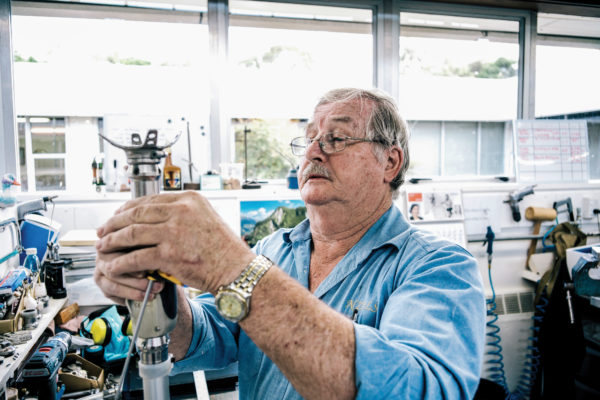

Behind the banter there’s a real friendship. There aren’t many people in New Zealand who are missing both legs. In 2011, the limb centre asked Leslie if he’d meet up with Winson and provide some inspiration. It worked. Leslie drove to Winson’s place, got out of the car, and walked up the steep driveway to the front door. Winson thought: “I need to be like this dude.”
Leslie, now 29, is a Wheel Black and Paralympic swimmer with three gold medals and a world record to his name.
Though their disabilities are similar, their backstories are very different. “I was born like this, no rhyme or reason why,” Leslie tells me. “My two brothers and sister were all born perfectly able-bodied; I was the last one out, and shock horror! Poor Mum and Dad had no bloody idea.”
But Leslie wanted to keep up with his siblings, running around on their Northland farm, and he found a way. He’s been coming to the limb centre since he was little. In the past few years, things have changed for the better, he says.
When Grey took over, he spent $1 million on providing 50 new microprocessor knees for above-knee amputees and training his staff how to prescribe them. Around 120 people are now using them, including Leslie and Winson.
They’re a huge step up from his old mechanical legs, says Leslie, both in comfort and in what they enable him to do—including something the rest of us take for granted: leaning.
“When you see people leaning against a post or a wall, I’ve always looked at it and gone, ‘Man, that looks comfy’, but I could never do that in the old legs, they would just collapse. Now, with the microprocessor, I can actually weight-bear through the knee and hold myself up.”
Since the new knees were brought in, there’s been a 95 per cent reduction in falls for those using them, says Grey.
That doesn’t mean they’re foolproof, says Leslie. “I cacked it this morning going into a cafe. I’d gone up the stairs—I was like, no worries—but there was a tiny little lip to come in, and I caught my toes and just cacked it.”
He ignored the stares and got up again. “I’m hard on my prosthetics, because I expect them to stand up to the test of being a young person.”
Winson, who is in his 50s, is no less ambitious. Just to show Leslie he can, he pulls on his long legs and walks down the hallway with a cane—the first time after his recent surgery that he’d walked without holding onto the bars along the wall.
“I wanted to show him that I really, really want to walk,” he tells me afterwards. “I was dead chuffed that I actually walked really nicely and smoothly and didn’t fall.” He and Leslie train at the pool together, and Winson’s talking about swimming competitively.
But his ultimate goal is to run again. He wants curving blades like those South African Olympian and Paralympian Oscar Pistorius used in races, and he’s determined he’s going to get them. The Accident Compensation Corporation imposes various physical tests on amputees before it will authorise expensive new gear, but Winson is adamant he’ll do the training and get there.
“I’ve been running since I was five years old. I just want to run on the track and feel the wind in my face… it’s the best. I can already feel what it would be like.”
Later, one of the physiotherapists at the Auckland centre, Peter Reid, reminds me that the people I’ve ended up speaking with are some of the most high-achieving individuals the service sees: “Most people are more at the quieter, unhealthier end of their lives.”
Motivation is important, he says, but there are other factors that determine what someone will be capable of after amputation.
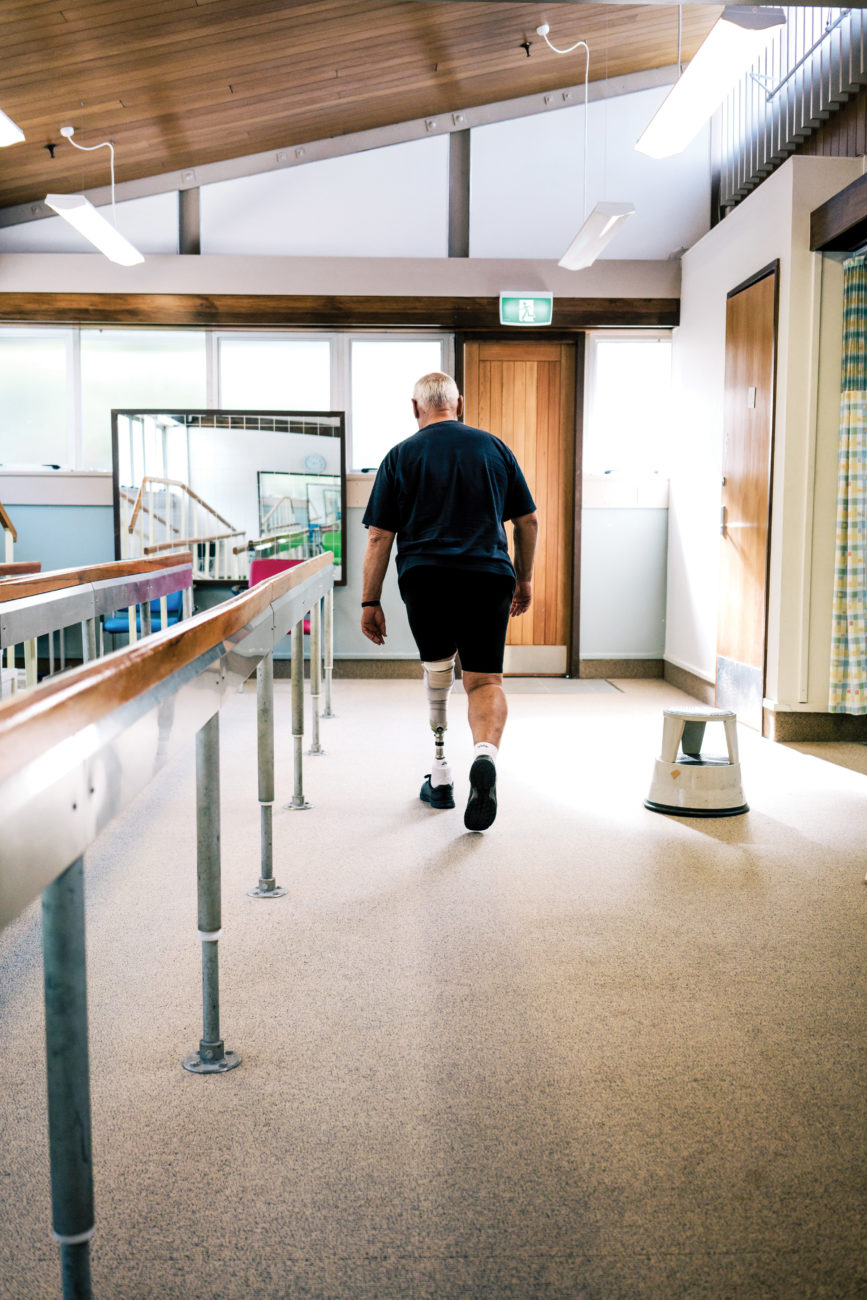
“Those other body systems matter, too—not just the mental one we think we can control. Does a person have nerve pain, or other mental health issues, are they in a supportive domestic situation, are they getting sleep, are their blood-sugar levels stable, is their cardiac output sufficient to walk across the room?”
In August 2019, NZALS will also begin providing psychological and peer-support services to amputees.
By the end of my day in the leg shop, I was looking at my limbs in wonder, appreciating everything they do for me—my prehensile hands, my flexible feet, the complex dance of toes-ankles-knees-thighs that allows me to jump without a second thought.
However dazzling the machines we make become, the human body is yet more marvellous. Humans have built submarines and spaceships, and we’ve made it to the moon and the top of Mt Everest.
Still, it’s taken 3000 years of prosthetic innovation to recreate a knee that can lean.
















